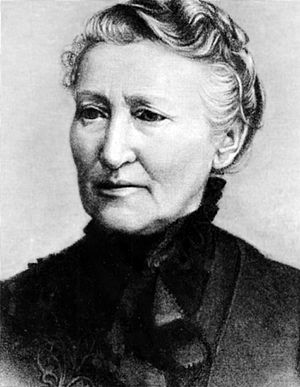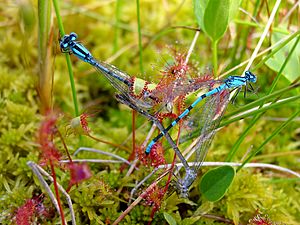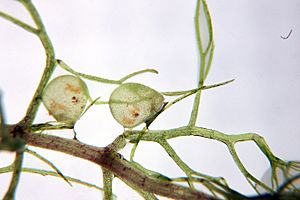Mary Treat facts for kids
Quick facts for kids
Mary Davis Treat
|
|
|---|---|
 |
|
| Born |
Mary Davis
September 7, 1830 |
| Died | April 11, 1923 (aged 92) |
| Occupation | naturalist and botanist, entomologist, author |
Mary Adelia Davis Treat (born September 7, 1830, in Trumansburg, New York – died April 11, 1923, in Pembroke, New York) was an amazing scientist. She was a naturalist, which means she studied nature, and she was also a friend and helper to the famous scientist Charles Darwin. Mary Treat made huge contributions to studying both plants (called botany) and insects (called entomology). Because of her important work, six different types of plants and animals were named after her! These include a beautiful flower called Zephyranthes treatae, a tiny wasp called Bellonocnema treatae, and three kinds of ants: Aphaenogaster mariae, Aphaenogaster treatae, and Dolichoderus mariae.
Contents
Mary Treat's Early Life and Education
Mary Davis was born into a regular family in Trumansburg, New York. When she was nine, her family moved to Ohio. There, she went to both public schools and special schools for girls. In 1863, Mary Davis married Dr. Joseph Burrell Treat. He was a professor and believed strongly in ending slavery. The couple lived in Iowa for a few years before moving to Vineland, New Jersey, in 1868.
Mary Treat's Career and Discoveries
After moving to New Jersey, Mary Treat really started her scientific studies. She worked with her husband on articles and research about insects. Mary Treat's very first science article was published in a magazine called The American Entomologist when she was 39 years old. Over the next 28 years, she wrote 76 science articles and five books!
Her research quickly grew from just insects to include birds (called ornithology) and plants. She wrote in detail about the birds and plants living in southern New Jersey, especially in a unique area called the Pine Barrens.
After she and her husband separated in 1874, Mary Treat supported herself by writing popular science articles. These articles appeared in well-known magazines like Harpers and Lippincott's.
In 1882, Mary Treat published a book called Injurious Insects of the Farm and Field. This book was so popular and helpful that it was printed five more times! She also collected plants and insects for other scientists. One of these scientists was Asa Gray, who then introduced her to Charles Darwin. Mary Treat wrote letters to many important scientists, including Darwin, Gray, Auguste Forel, and Gustav Mayr, to discuss her findings.
She traveled to Florida several times between 1876 and 1878. She went there to learn even more about plants that eat insects. During one of these trips, she discovered a new type of lily, which was named Zephyranthes treatae after her. She also found that another type of lily, which people thought was gone forever, was actually still alive!
Because of her important work in studying insects, Mary Treat was made a member of the Cambridge Entomological Society. This was a big honor!
How Mary Treat Worked with Charles Darwin
The first time Mary Treat and Charles Darwin wrote to each other was in December 1871. In her letter, Mary described how Drosera plants, also known as sundews, catch flies. Mary Treat and Darwin wrote letters back and forth for about five years. This was around the time Darwin was studying and writing his book about carnivorous plants (plants that eat insects). They mostly talked about these amazing plants in their letters. Mary Treat even shared her own ideas and sometimes questioned Darwin's theories.
One important discussion they had was about a plant called the bladderwort, Utricularia clandestina.
Darwin's teacher, John Stevens Henslow, understood what bladderwort plants looked like, but he couldn't figure out how their traps worked. Darwin thought that animals entered the traps by pushing their heads through a small opening. He even wrote to Mary Treat that this topic was driving him "half-mad"!
Mary Treat became very interested in this problem. She spent many hours watching the traps under her microscope. She discovered that tiny hairs around the trap's entrance were sensitive. These hairs helped the Utricularia traps open. She also learned about the different tiny animals these traps caught and how the plants digested them. Mary Treat described these tiny traps as "little bladders... in truth like so many stomachs, digesting and assimilating animal food."
Darwin was so impressed by Mary Treat's work on carnivorous plants that he mentioned her many times in his book Insectivorous Plants (published in 1875). He included her findings in the main text and in footnotes. By doing this, Darwin showed everyone that Mary Treat was a true scientist.
Mary Treat's Lasting Impact
The best collection of information about Mary Treat's life is kept at the Vineland Historical and Antiquarian Society. Also, a complete book about her life, called Mary Treat: A Biography by Deborah Boerner Ein, was published in 2022.
Harvard University has some of the plant samples Mary Treat sent to Asa Gray, along with their original letters. You can also see many of her original letters to Charles Darwin through The Darwin Correspondence Project and at Cambridge University Library.
The ant Aphaenogaster treatae was named after Mary Treat by a Swiss scientist named Auguste Forel. He did this to honor her for finding ant samples in Florida and New Jersey. An Austrian scientist named Gustav Mayr named an oak fig root gall wasp called Belonocnema treatae after her. She discovered this wasp on a Virginia oak tree in Florida.
Mary Treat was even a character in a historical novel called Unsheltered, written by Barbara Kingsolver in 2018.
Mary Treat's Published Works
Many of Mary Treat's books and articles described her observations of insects and birds. She wrote in a way that was easy for everyone to understand.
- Chapters on Ants (1879)
- Injurious Insects of the Farm and Garden (1882)
- Home Studies in Nature (1885)
- Through a Microscope (1886)
- My Garden Pets (1887)
- Asa Gray: His Life and Work (1890)
See also
 In Spanish: Mary Treat para niños
In Spanish: Mary Treat para niños



